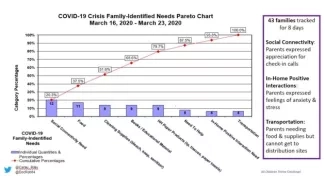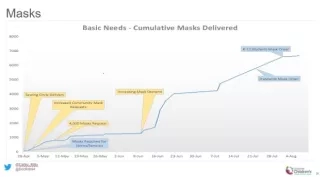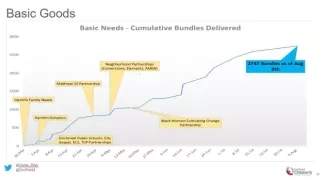Why It Matters
In mid-March of 2020, as the COVID-19 pandemic and stay-at-home orders rolled in, we had to decide how to respond. Since 2015, we had been building a learning network in Cincinnati, a city of 300,000 people, including 66,000 children and youth, 40 percent of whom are living in poverty.
The mission of this network is to help the city’s children be the healthiest in the nation. To achieve this mission, we have provided a structure, methods, and expertise for partners from multiple sectors to apply quality improvement science in their organizational efforts to help children thrive. Now, in the time of crisis, we had to quickly understand and respond to emerging threats and decide if and how our current work and improvement methods remained relevant.
Some saw the planned engineering aspects of QI as incongruent with the urgency and ambiguity of the circumstances, while others embraced the tremendous utility of rapid cycle testing to learn and adapt. Facing the challenges inherent in a crisis, we found ourselves turning to rather than turning away from QI. Rather than think that we didn’t have time for QI, we realized that we didn’t have time for anything other than QI. In turning to QI, we found ourselves going back to the basics, asking the same fundamental questions repeatedly. It was these questions and their answers that gave us power and clarity during a crisis.
We asked:
- What does success look like? How will we know whether we are achieving it?
- What do the data tell us? Who needs what where?
- Who else is in this work? Who are we in this work?
What does success look like?
We grounded ourselves repeatedly by asking what exactly we were trying to achieve and allowing the outcomes to emerge and evolve over time. We would ask ourselves frequently at what scale we should be working. We reaffirmed equity as a core principle and primary outcome. And then we let outcomes, scale, and principles drive innovation, learning, action, and urgency.
As the pandemic and social policies to contain the pandemic exacerbated existing conditions and problems and created new conditions and novel problems, we found ourselves in new roles, pursuing new activities, with new partners, and with new rules, with many bureaucratic barriers to innovation and collaboration removed or lessened. There was energy and hope in all this newness, but there was also challenge. A shared vision of what success would look like, and just enough data to know we were making progress, helped to harness the energy and overcome challenges.
What do the data tell us?
We knew we needed to let data, including family and community voices, drive our action. We started small and aimed to gather just enough data to decrease uncertainty and build will. We quickly worked with a few dozen families to identify their prioritized needs, including social connectedness, enough nutritious food, basic goods, trusted information, and ways to contribute to help others.
We used QI tools to decrease ambiguity and bring clarity, direction, and alignment: Pareto charts to clearly communicate families’ priorities (Figure 1), key driver diagrams (Figure 2) to generate shared theory and disciplined action across rapidly developing collaborations, FMEA diagrams to illuminate challenges and identify potential solutions, and run charts to assess effect over time. We returned repeatedly to the data to know who needed what where.


Who else is in this work?
We scanned the landscape repeatedly. We applied continuous learning to locate and identify who was doing what in our rapidly changing system, the gaps and unmet needs, the redundancies and inefficiencies, and the untapped assets. We used this iterative landscape scan to determine where we applied ourselves and what areas of action we would prioritize for ourselves. In this, we would not only ask who else is in this work but also who are we in this work. We would ask: do we have a role in this work? If so, what is that role? Are we a catalyst, convener, champion? Are we a supporter or a leader?
Early in the pandemic, we determined that the emergency food system was self-organizing, with the city’s public school system and government each providing essential elements. Yet, we recognized the lack of a systems perspective to ensure vulnerable families had reliable local access not just to food but also to basic goods and trusted information. As such, we set out to build on the developing infrastructure and catalyze systems change to facilitate delivery of all masks (Figure 3), food, basic goods (Figure 4), and information in a scalable way.


We discovered that QI provided the principles and practices we needed to navigate. QI was not a luxury item to be put down in times of crisis. Rather, QI was a fundamental approach to moving through the confusion and paralysis induced by the chaotic state to characterizing the complex set of emerging conditions and disciplined action required. It was a simple matter of asking and answering a series of basic questions over and over.
As we pivoted our efforts to focus on emerging health-related needs such as isolation, food insecurity, and COVID-19 testing, we embraced new opportunities as well as the ambiguity, uncertainty, and unknown. We acknowledged the emotional responses, such as grieving pre-pandemic work that ground to a halt, while also moving forward with purpose.
QI provided the way for us, as a health care system, to respond with agility, urgency, and action, to center the needs of the community, and to work with others. We are also hopeful that the core strengths of QI – outcomes, scale, theory, learning – have also given us the way to build new and improved systems for what we hope is an even better future.
Carley Riley, MD, MPP, is Assistant Professor, at IHI Strategic Partner Cincinnati Children's Hospital Medical Center. Robert Kahn, MD, MPH, is the Executive Lead, Community and Population Health, Cincinnati Children's Hospital Medical Center. Learn more at session D11: Quality Improvement at the Interface of Health Care, Public Health, and the Community at the IHI Forum 2020 at which they will be co-presenters.
